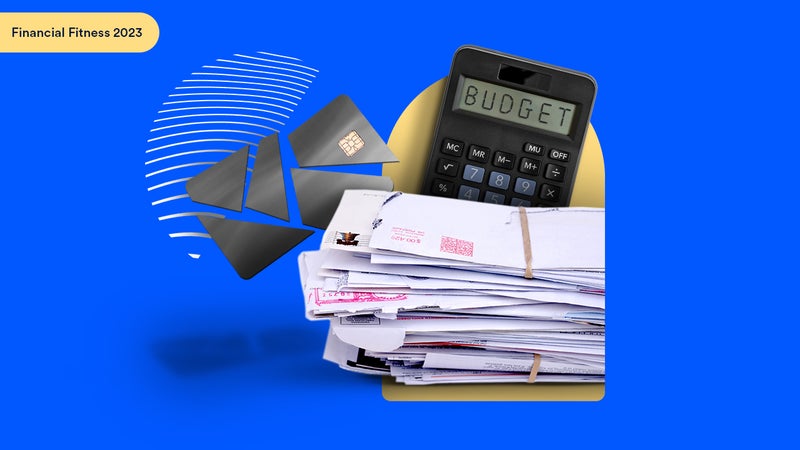So you haven’t been sticking to your resolutions. Here’s how to reset and crush the next 11 months.

The Bankrate promise
At Bankrate we strive to help you make smarter financial decisions. While we adhere to strict , this post may contain references to products from our partners. Here's an explanation for . The content on this page is accurate as of the posting date; however, some of the offers mentioned may have expired. Terms apply to the offers listed on this page. Any opinions, analyses, reviews or recommendations expressed in this article are those of the author’s alone, and have not been reviewed, approved or otherwise endorsed by any card issuer.
Key takeaways
- New Year’s resolutions can be hard to stick to, no matter how well-intentioned you are about your new goals.
- If your resolutions have fallen by the wayside, you might benefit from reevaluating your strategy and setting more specific goals.
- Following the SMART goal strategy can help you turn your resolution into actionable items — just don’t forget to give yourself grace as you make mistakes and figure out what method works best for you.
Nearly 9 in 10 Americans (86 percent) had at least one financial goal going into 2024, according to a recent Bankrate survey. But having a goal and being able to take steps to achieve it are two different things. If you’re one of the millions of people who set New Year’s resolutions every year, especially financial ones, you’re likely familiar with this hamster wheel. You have high hopes in December of making positive changes to your life as soon as the clock strikes midnight, but by the end of January, things have gone awry.
If that sounds familiar, don’t worry — here’s how to make a strong comeback.
Set SMART goals
Maybe you’ve heard about this goal-setting technique, but it’s always a good time for a refresher. SMART goals can ease the process of creating a successful 2024 roadmap.
What is a SMART goal? Rather than having something vague like “save more money” or “read more,” a SMART goal helps you create a path to success.
SMART goals
- Specific: What are you saving money for — an emergency fund? A vacation? A down payment? All of the above? Be specific about why you want to achieve your goal.
- Measurable: How much do you want to save? A total amount, like $10,000? Or maybe a fixed amount per month, like $100? Put real numbers on your goal so you know where to aim.
- Achievable: Thinking about your life, are you actually able to achieve this goal? We all want to save as much as possible, but we need to set goals within our limits. Otherwise, we’re just setting ourselves up for failure. Does your savings goal fit within your budget?
- Relevant: How important is your savings goal? Will it improve your life in a way you’ve previously found lacking? Does it fit in with your long-term picture, or are you simply doing it because you think you should?
- Timebound: Give yourself a deadline. When do you want to reach your savings goal? Without a deadline, it’s too easy to weasel out of it. A deadline helps you make a commitment.
Here’s what a SMART resolution to save more money might look like: Save $100 per month so that by this time next year, you’ll have $1,200 set aside for emergencies to protect your family. To fortify your plan, you can even set up automatic savings transfers with your bank each month.
Give yourself permission to fail (at least temporarily)
It’s all too easy to focus on your failures and toss the whole thing out the window the first full week you don’t follow through with your goal. Instead, try something different: Give yourself permission to fail, at least for a bit. Expect that you will. Embrace it as part of the process.
And then, give yourself permission to get started again. No matter how many times it takes, give yourself grace so that it’s easier to start again rather than being a source of shame and avoidance. Celebrate getting back on the wagon (again… and again… and again, if necessary) just as much as you celebrated your goal at the start of the new year.
Over time, you’ll probably find that each time you restart, you’ll be able to go just a little bit longer each time — until eventually, you’re able to keep up your new habit for good. After all, a 2016 study from the Ontario Tobacco Research Unit showed that it actually takes most smokers 30 or more attempts to quit before finally becoming successful. If you stop trying to pursue your goal after a small failure, you may never get there.
Assess what isn’t working
When we create goals, we set them with the best information we have at the time. But sometimes, we don’t have the full picture.
Maybe you want to get healthier, but an undiagnosed medical condition is preventing that. Other times, we might be a bit too ambitious. It’s hard to figure out a good amount to save if you haven’t set up a budget. Or — more commonly — things change, and what used to be attainable no longer is. Maybe you wanted to take a luxurious vacation, but inflation’s hit your wallet so hard that you’re no longer able to save toward this goal.
In any case, if you find that you’re coming up short in reaching your goals consistently, it’s a good idea to step back and try to diagnose why.
Do you find it hard to stick to your budget because you don’t want to log in and update it? If so, what’s behind that fear — are you afraid you won’t have enough money, or that you’re never able to reconcile your balances with your budget? Maybe it’s not fear at all and you just find the updates tedious. In that case, something like a budgeting app that updates automatically might help you better manage your goals.
Keep in mind: Figuring out why your goal isn’t working lets you identify areas that you can smooth out so that it does work going forward.
Adjust your goals if needed
If you’ve failed several times, figured out why it’s not working, and can’t figure out a good way to fix it, an update to your goal might be in order. The same applies if your situation suddenly changes and your goal isn’t achievable anymore.
Think about what you wanted to achieve — saving more money for a vacation, learning to budget, increasing your income, etc. — and figure out how you can change your goal so that you still reach your ultimate objective.
Ideas to adjust your goals
- Scale it back: Instead of saving $200 per month, maybe all you can do is $100 or even just $10 — but that’s still progress. If you can’t get a raise at work, consider taking on a side hustle.
- Adjust your timeline: If you’d hoped to save $4,000 for a European vacation by next year, maybe postponing your trip for another year so you can keep saving is a viable option. If your goal was to pay down your debt in a year, give yourself two years to do it.
Adjust your strategies
Your goals are what you’re trying to achieve, but your strategies are how you get there. And if your strategies aren’t working, they may also need an update of their own.
Ideas to adjust your strategies
- Create a budget: Without a plan for your money, it’s hard to reach your goals, whether it’s to spend less money or save for a certain goal. There are budgeting styles that can fit almost any lifestyle.
- Create a schedule: If your goal is time-based, like wanting to spend more time with family or more time exercising, try creating a schedule with time blocked off specifically for that goal.
- Use a to-do list app: To-do list apps like Todoist and Microsoft To Do can help you by setting up recurring reminders for you according to specific time frames, like every day or every other Thursday.
- Use a habit tracker app: Similar to a to-do list app, habit-tracking apps like Habitica and Beeminder allow you to gamify and track your progress toward one or more goals at a time.
- Try new tools: If your goal involves being more active, maybe signing up for a new gym membership or some online workout classes will help. Similarly, if your goal is money-related, consider looking into popular tools like balance transfer cards to reduce debt or travel rewards cards to earn points toward a trip.
- Find a support group: Tough goals, like boosting your health or getting out of debt, are sometimes easier to achieve if you meet with a support network of friends going through the same challenges as you on a regular basis.
Remember to appreciate your progress
Along the same lines as giving yourself permission to fail, it’s also important to appreciate any progress you make. Maybe you didn’t reach your goal of 52 hikes in a year, but even if you only made it to five hikes, that’s still five fun experiences you got to go on.
You can also try setting up rewards along the way to help motivate you and make you appreciate the small steps you’re taking toward your larger goal. For example, for every week that you go while spending less time on social media, you could reward yourself with something else you like, such as a fun book or video game.
And if you’re still having trouble reaching your SMART goals? Don’t be afraid to ask for outside advice. A professional nutritionist or personal trainer can help you become healthier, while an accredited financial advisor or a licensed credit counselor can help you get a better grasp of your finances.


